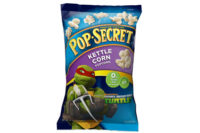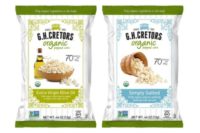Americans are gobbling up popcorn by the bucket load. The sector is reinventing itself from the salty, ‘imitation-butter’ profile of its past to a clean-label version with fresher flavors. Thus, consumer demand and economics are reshaping its future.
If you ask Jeffrey Price, partner at Snacks 101 and Hampton Popcorn, Bethpage, NY, popcorn is a classic and wholesome snack “as American as baseball or apple pie,” he says. Indeed, Americans are gobbling up popcorn by the bucket load. According to The Popcorn Board, a nonprofit organization funded by U.S. popcorn processors, Americans consume 16 billion quarts of the popped snack annually. That’s 51 quarts per man, woman and child; of that, about 70% is eaten in the home, while the remaining 30% is enjoyed at the many stadiums, theaters and other outlets that recognize popcorn as an affordable and nostalgic “home run” at the concession stand.
“The industry is in a state of continual expansion because popcorn is relatively inexpensive, and the capital investment is low compared to other products,” explains Eric Girard, vice president of sales and marketing at Waterloo, WI-based Van Holten’s. “It’s easy for an existing food company to add this item, or for an entrepreneur to introduce a new product.”
But it hasn’t always been a smooth ride for popcorn. According to Adriane Little, Earth Balance category manager at Boulder Brands, Boulder, CO, the popcorn industry experienced a bit of a setback during the recent recession, as shoppers cut back on nonessential purchases. But today, shoppers are going back to this childhood classic, though with some trepidation that leads them to purchase different popcorn than they did pre-recession. “They’ve become more health conscious,” Little says. “The popularity of popcorn heavy in fat, salt and artificial ingredients is waning and in its place are a plethora of gourmet and natural popcorns sure to satisfy any connoisseur.”
Chemical complications
Additionally, some bad press surrounding alleged health risks of microwavable popcorn added another hurdle to a complicated landscape. Topping concerns was that some microwavable popcorn contains diacetyl, a byproduct of fermentation and a chemical synthesized by manufacturers to give foods a buttery flavor and aroma. According to the U.S. Department of Labor’s Occupational Safety and Health Administration (OSHA), employees exposed to food flavorings containing diacetyl developed serious respiratory illnesses and exhibited symptoms like dry cough, wheezing, shortness of breath and airway obstruction.
Another blow to popcorn’s public image came in the form of perfluorooctanoic acid (PFOA), a chemical used in the lining of many microwavable popcorn bags. According to the American Cancer Society, PFOA is present in nearly all Americans’ bodies, but tests on lab animals showed the chemical increased tumors in the liver, testicles, mammary glands and pancreas; and human tests showed that people who work with the chemical have higher risks of bladder and kidney cancers.
“For the last three years, sales of microwavable popcorn has been declining slightly, while pre-popped and raw-kernel sales have increased pretty significantly,” affirms Garrett K. Smith, president of American Pop Corn Co., Sioux City, IA, the maker of Jolly Time Pop Corn. In response to these concerns, the company removed all diacetyl from its microwavable popcorn products in 2007 and confirms that there are no detectable levels of PFOA in its bags during manufacturing. Between the bad press and the general movement toward healthier products, the popcorn industry is reinventing itself from the salty profile and imitation butter of its past into a clean-label version with fresh flavors for the future.
Healthy demands
As consumer scrutiny of all food products has hit an all-time high, popcorn manufacturers are shifting focus toward the intrinsically healthier attributes of their product.
“Increasingly, people are looking for organic, healthy alternatives to traditional snacks like chips, cookies and candy,” agrees Jeff Schletewitz, founder and CEO at KettlePop, Benicia, CA. In 2013, KettlePop introduced Organic KettleCorn and Sea Salt popcorn varieties.
“These meet the demand for organic and nongenetically modified organisms (GMO), while also being gluten-free, containing whole grains and being high in fiber, low in fat and high in taste,” Schletewitz continues. And if shoppers are looking for a clean label, the company meets and even may exceed their expectations. KettlePop Sea Salt has just three ingredients: Organic corn; organic soybean oil; and sea salt. The KettleCorn variety has just one additional ingredient: Organic sugar. “Our customers can be assured that when they eat a KettlePop product, they are eating a wholesome, real food, free of synthetic chemicals or pesticides.”
Simple ingredient lists will win the game, agrees Meyer Futersak, CEO of American Farmer Brands LLC, Cedarhurst, NY. The company’s Sweet & Salty Kettle Popped Corn contains just popcorn, sunflower oil, sugar and salt; similarly, its Light and Skinny Kettle Popped Corn for the health-conscious contains the same ingredients, but cuts 10 calories per serving.
Consumer trends for better-for-you snacks have also influenced G.H. Cretors, Waukegan, IL, as it recently introduced two organic items to its lineup: Extra Virgin Olive Oil; and Simply Salted popcorn. Both items are also gluten-free and Non-GMO Project-verified. “For some time, popcorn had become a bit commoditized,” says president Claire Cretors. “But over the last few years, brand builders have changed the perception and created healthier products with cleaner labels, to stay in-line with consumer demands.” G.H. Cretors answers this demand by using ingredients like brown rice syrup, instead of corn syrup, and real butter, brown sugar and real cheese.
Virginia Bryant, marketing and brand associate at 479°, San Francisco, explains that this focus on healthy snacking—particularly on whole-grain, gluten-free and low-calorie snacks—is driving the popcorn market to be one of the fastest growing in the snack aisle. The company recently launched Asiago, Parmesan and Cheddar, Toasted Sesame and Seaweed, and Farmers Market Herbs varieties. Like other brands, it puts the calorie count and nonGMO, gluten-free and kosher certifiers on its labels, “so that it’s easy for consumers to make a healthy choice at the store shelf,” she adds.
Sea Cliff, NY-based SexyPop taps into this trend by offering gluten-free, nonGMO popcorn in fun varieties like French Butter, Bodacious Banana, Sweet Habanero and others with “more antioxidants than broccoli,” says the company’s CEO, Robert Ehrlich.
One new option on the market for healthy shoppers is Snacks 101, a baked popcorn variety that comes in many flavors: Smoky Chipotle; Sweet and Spicy Sriracha; Less Mess White Cheddar; Purely Sea Salt; Brown Sugar Cinnamon Kettle Corn; and Sweet and Salty Kettle Corn. “Other kettle corn on the market is wet-popped,” explains Price. “That means their raw kernels are actually fried in hot oil. Ours is not made that way. That’s why we’re able to make the flavors we make and, at the same time, provide tremendous health benefits.” The product launched in May and boasts the health benefits of pure coconut oil.
New from SH Foods, Mokena, IL, is Cooking Light Simply Sea Salt Popcorn, produced in tandem with the eponymous magazine. It is free of trans-fats and boasts just 35 calories per cup.
Gaslamp Popcorn, Riverside, CA, is also tapping into the low-cal craze with its Sea Salt & Olive Oil Popcorn, which will launch in September. “It’s high in fiber, and is a light but savory snacking option,” states Mark Singleton, vice president of sales and marketing. “It only contains 37 calories per cup.” Both lines are gluten-free and nonGMO.
Not all diets are about losing weight. For Earth Balance, it’s as much about specialty needs diets. Its Kettle Chips are now available in Sea Salt, Vegan Cheddar and Vegan Sour Cream and Onion, without the dairy.
Fearless flavors
Like all consumers, popcorn eaters are looking for that adventurous something extra: Exciting, new flavors. “Bold and different flavors are now the norm, and there are different flavors popping up every day,” says Girard. “Jalapeno, sriracha, ginger, bacon, chipotle and others are all prevalent. It’s not just savory and sweet; it’s both flavor profiles, and often in the same bag.”
Van Holten’s is tapping into this trend with its Big Papa Dill Pickle-flavored popcorn, which launched May 2013. While the product is gluten-free and popped in coconut oil, Girard explains that the company’s priority in the marketing of this product is its bold and unique flavor.
“Popcorn flavors are a lot more unique in today’s market than even just a couple of years ago,” agrees Alan Petrik, chief operating officer and president of The Popcorn Factory, Lake Forrest, IL. “Companies need to continuously grow their range of flavors to help attract the palettes of consumers. Sea salt and caramel, bacon and sriracha have all been flavor trends within the last few years.” To that end, The Popcorn Factory recently launched a LITE WORKS line, which boasts just 50% of the fat content of its traditional varieties and offers exciting flavors like Sriracha, Wasabi Soy and Dill Pickle.
“Jalapeno everything” has already entered the picture. Last fall, American Pop Corn also launched a Jalapeno Butter variety.
And indeed, sriracha is a trend worth following. POP Gourmet Foods will soon launch a popcorn created in tandem with the maker of the original Sriracha Hot Chili Sauce, Huy Fong Foods.
Packing it in
From single-serve to eco-friendliness, packaging helps manufacturers differentiate themselves in a category overloaded with options. Van Holten’s Pickle-in-a-Pouch succeeds in the convenience-store channel and has differentiated itself as a grab-and-go brand; its popcorn venture mirrors this goal, with a 2.2-oz. bag. The small bag size also optimizes shipping, adds Girard. “Retailers only have so much shelf space,” he says. “Big companies with existing product on the shelf and existing distribution have a huge advantage on getting their product placed. The simple fact that we can ship Dill Pickle Popcorn with our pickles has probably been the number-one reason we have been successful at growing sales and distribution of our popcorn.”
But perhaps the biggest trend is in enviro-friendly packaging. “Consumers are looking for healthy snack alternatives and packaging needs to reflect the product inside,” says Schletewitz. KettlePop switched out the ink traditionally used in packaging for solventless, waterbased ink, and its cartons are manufactured using 90% solar power. “Our target consumers are health-conscious and believe in organic, healthier snacks,” he adds. “They’re concerned about the environment and growing practices used for their food. Popcorn as a snack will continue to see strong growth during the next decade and beyond. We anticipate more consumers and retailers accepting the product as a healthy snack alternative.”
“The popcorn category will continue to grow,” Singleton agrees. “Consumers want to find healthier alternatives to their usual savory or sweet snacks. Popcorn can be considered guilt-free snacking, and consumers want more of these options.”










